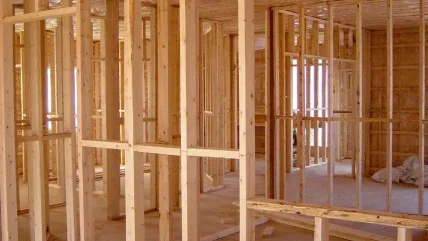
The improvement in the chipboard sector’s fortunes, which started mid last year, has continued, in fact so much so that there was no pause in trading over the traditionally quieter summer months.
In fact one UK manufacturer reported its highest turnover of the year in the month of July and the other two are also happy with the level of trading.
The increase in housebuilding activity is thought to be the main driver, boosting demand for all chipboard products, from raw board through to MFC.
“Probably the first impact was on the raw side and now MFC demand has started to kick in, which makes sense because the more houses that are finished, the more furniture and kitchens are required,” said one producer.
With the UK economy strengthening and the election next year there’s little likelihood of anything upsetting the equilibrium, so manufacturers expect the steady improvement to continue, although any sudden spurt in demand could cause supply issues.
“We’re trying to run everything as flat out as we can,” said one producer. “All the manufacturers are pretty much running at full capacity so it would be difficult at certain times to meet any major increases in demand.”
As revealed by the latest Timber Trade Federation statistics (see graphs), imports have increased as demand has risen, and the recent strengthening in sterling will make the UK more appealing to European producers. However, supply is also tight in Europe.
“There’s not much surplus available all over Europe so supply will remain as it is for the rest of the year,” said another producer.
But, he added, at least it’s creating a situation where chipboard is profitable again.
“Making money on plain chipboard doesn’t happen very often. Probably many manufacturers are making more money out of chipboard than MDF, which is a contradiction because MDF is more value added, but it’s availability more than anything else,” he said.
This was reiterated by an importer who said the fact that two UK manufacturers’ focus had increased on P5 flooring grade chipboard meant customers wanting other grades had turned to MDF and, in some cases, OSB.
“In the cheaper end of the market there’s been some substitution for OSB,” he said. “But if you’re a laminator you need chipboard or MDF. There’s not much difference between the price of the two and if you can’t get chipboard quickly enough, you’ll go for MDF.”
The UK mills introduced a price increase in the spring, and further rises were implemented at the start of this month. One has raised MFC prices by around 5% and raw board by 8%, while another’s have gone up 4-8%, depending on the product. They are reasonably healthy rises and mills’ profitability has improved “but it’s nowhere near what it was before the recession”, TTJ was told.
“There were many years when it wasn’t possible [to raise prices]. We had cost pressures but had to take care of our customers because it makes no sense if they can’t pass it on.”
A distributor said the spring price rises were difficult to hold but he believed the market was ready to accept the latest hikes.
“There’s a limit to where you can go [for chipboard] and I can only see prices going up as markets pick up,” he said.
He added that those who wanted guaranteed supply of P2 were already paying more because they were buying Belgian product.
Manufacturers’ chemical and energy costs have generally been steady over the summer but timber prices are rising and likely to continue to do so. Demand from the construction industry is one reason but panel manufacturers place most responsibility on the demand for biomass.
“The strain on timber continues because biomass plants are still being built,” said one producer. “As an industry we’ve had some success in avoiding the worst excesses but there are still new plants coming along.”
Another producer estimated that timber costs had risen 15% over the past 12 months.
“The sawmill industry has been quite busy so there are a lot of residues around compared with in the past, so we would have expected our wood costs to soften a little, but in reality there’s more demand for that type of material so that’s impacting on the price,” he said.
Chemical prices have been stable for the past six months, although they are subject to volatility, and the warm UK summer has kept energy prices down for those buying on the spot market. However, these could rise with winter demand, and especially if Russia chooses to use its gas and oil supply as a weapon against Ukraine.
Timber costs aside, manufacturers’ profitability has improved and they are generally content with order intake and production levels.
“It’s more an issue of getting enough made than selling enough – which is a much better problem to have,” said one.





